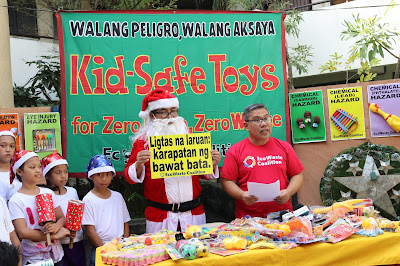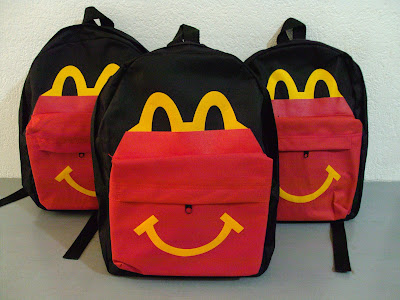Groups Push for Children’s Safety from Hazardous Toys as Christmas nears
Consumer and environmental protection groups today reminded the public to be watchful for hazardous toys in the market that can bring harm rather than joy to children.
At a press briefing held today, the EcoWaste Coalition and the Laban Konsyumer, Inc. rallied consumers to exercise their rights to product information and product safety amid the toy shopping spree as the traditional Christmas gift-giving nears.
“We appeal to all gift givers to be extra careful when buying toys as the market is flooded with dangerous toys that are often unlabeled and unregistered,” said Thony Dizon, Chemical Safety Campaigner, EcoWaste Coalition.
“While toys are generally fun and safe to play with, there are toys out there that can pose various hazards from chemical poisoning, choking, skin laceration, strangulation and even injury to sensitive body parts like the eyes and ears,” he said.
“As children are vulnerable to the negative effects of poorly made and toxic toys, toy makers, distributors and retailers must be responsible enough not to offer toys that have not passed quality and safety verification, including compliance to product labeling requirements,” he emphasized.
For his part, Atty. Vic Dimagiba, President of the Laban Konsyumer, Inc. pointed to the need for heightened monitoring of toys to rid the market of products that can put the health and safety of children at risk.
“As shoppers flock to their favorite stores, the government needs to assure consumers that toys being sold in the market are not only affordable, but also properly labeled and of good quality,” he said.
“Sustained monitoring of the marketplace is needed to stop the sale of toys and other popular Christmas products that may inflict harm to children’s health,” he added.
Clinical toxicologist Dr. Bessie Antonio of the East Avenue Medical Center further stressed the consumer vigilance against toys that are laden with hazardous substances such as endocrine disrupting chemicals, heavy metals, and persistent organic pollutants.
“Consumers should avoid toys containing hazardous chemicals. Lead in painted toys, in particular, may be ingested by children through normal hand-to-mouth behavior. Chronic exposure to lead can interfere with a child’s growth and development resulting in lower intelligence quotient (IQ), poor school performance, reduced attention span, and anti-social behavioral,” she explained.
According to the latest toy sampling conducted by the EcoWaste Coalition involving 156 products bought from toy retailers in Baguio, Manila, Cebu and Davao Cities:
a. 20 out of 156 toys had lead levels above the regulatory limit of 90 parts per million; traces of other heavy metals such as antimony, arsenic, cadmium and chromium were also detected in some toys;
b. 85 of the 156 toys contain small parts that can pose a choking hazard; some toys were also found to pose eye injury, laceration, and strangulation hazards;
c. None of the 156 provided complete product labeling information as required by Republic 10620, or the Toy and Game Safety Labeling Act and its Implementing Rules and Regulations.
To reduce children’s exposure to harm arising from the purchase and use of dangerous toys, the EcoWaste Coalition recommends the following “Santa’s shopping tips” for safe toys:
1. Choose age-suitable toys. Check the recommended age on the product label and select the one that is appropriate to your child’s age, abilities, habits, and maturity level. Refrain from buying toys that are not labeled for age appropriateness.
2. Pick toys that are durable and well-made. A sturdily made toy will last longer and will be safe for parts that could break or fall apart with frequent use. Detached or shattered parts could injure or pose a choking hazard to a curious child.
3. Shun toys with small parts to reduce the risk of choking. Marbles, tiny balls and toys with button batteries and small components pose a choking risk. As a general rule, toys and toy parts should be bigger than a child’s mouth.
4. Avoid toys with a cord longer than 12 inches to prevent strangulation incidents. Toys with a cord or string longer than 12 inches can be deadly as it can wrap around the neck and asphyxiate a child.
5. Go for injury-free toys. Refrain from procuring toys that can injure a child’s ears, eyes, skin and body such as toys with pointed parts, sharp edges and those that can eject small objects such as toy pellet guns.
6. Reject lead painted toys. Refuse coated toys if there is no assurance that the paint used is safe from lead, a neurotoxin. Toys should be painted only with lead safe paints to prevent a child from being exposed to this toxic chemical that can cause intellectual impairment and mental retardation, among other adverse effects.
7. Avoid toys made of polyvinyl chloride (PVC) plastic. PVC plastic toys contain chemicals additives such as toxic phthalates that can leach out when a toy is chewed or sucked.
8. Patronize duly labeled and registered toy and childcare articles (TCCAs). Notified TCCAs have undergone quality and safety assessment by the Food and Drug Administration (FDA).
-end-










Comments